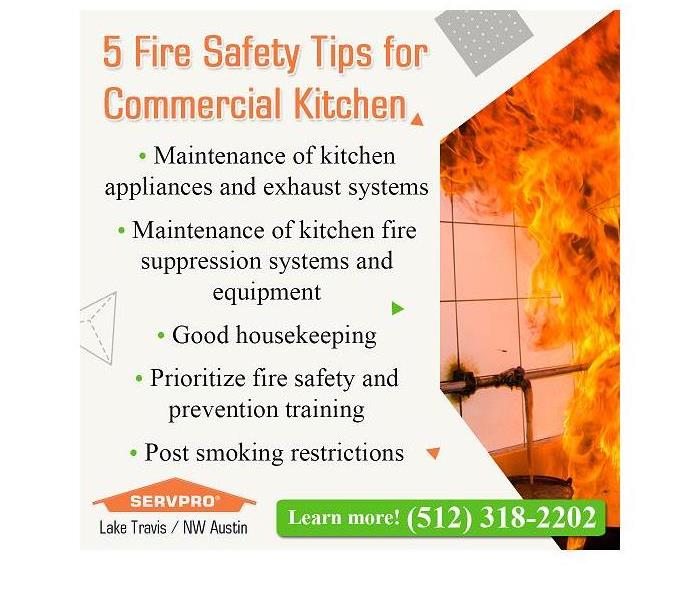SERVPRO: 6 fire safety tips commercial kitchens can follow
6/29/2021 (Permalink)
Blog summary: The SERVPRO article talks of 6 fire safety tips that can help commercial kitchens prevent fires.
6 fire safety tips for commercial kitchen
Statistically maximum fires start in kitchens every year. Therefore it is crucial to understand and implement best practices for fire safety in kitchens, primarily in three areas: preventative maintenance, good housekeeping, and employee training. According to SERVPRO, following these tips can significantly reduce the risk of fire damage in kitchens.
- Maintenance of kitchen appliances and exhaust systems
- Regular inspection and maintenance
Look out for fire hazards as mentioned below to prevent electrical fires
- Frayed cords or wiring that can spark and cause an electrical fire.
- Cracked or broken switch plates on outlets.
- Cords running behind appliances, which should be checked and moved to a more visible location.
- Professional repairing
It is advisable to get commercial kitchen appliances maintained and repaired by professionals due to the complexity of modern equipment.
- Deep fat fryers and open flame cooking
- The fryers should be kept at least 16 inches away from any source of an open flame. Alternatively, a vertical divider that extends at least 8 inches above the top of the fryer can be installed. These measures prevent the hot oils in the fryer from splashing onto an open flame and igniting.
- All deep fat fryers should also be equipped with a high-temperature limiting device.
- Inspect and clean exhaust system
Required by fire safety codes, exhaust systems require different inspections and cleaning schedules depending upon the type of cooking operations.
- Maintenance of kitchen fire suppression systems and equipment
Complying with fire safety regulations regarding the inspection, testing, and maintenance of the kitchen fire suppression system, including fire alarms and emergency lighting, is crucial for a prevention plan.
- Portable fire extinguishers as a backup
While Class K fire extinguishers are necessary for commercial kitchens for fires involving grease, fats, and oils that burn at high temperatures, it’s also advised to keep Class ABC extinguishers on hand for other types of fires (paper, wood, plastic, electrical, etc.). All fire extinguishers should be checked monthly and inspected and recertified annually.
- Test kitchen fire suppression system
Kitchen suppression systems, generally very effective, can fail due to a lack of maintenance.
- Regularly test fire alarms
Fire alarms are the first line of defense against fire as they alert occupants instantly, enabling quick escape. They must be inspected regularly to ensure efficiency.
- Test emergency and exit lighting
Electrical power may be lost during a fire emergency. Properly functioning emergency lighting will ensure the occupants can find their way to safety if the power goes out during an emergency. Regular inspection and annual testing of all emergency and exit lighting systems must be done.
- Good housekeeping
According to the data from NFPA, National Fire Protection Association, 22 percent of the commercial kitchen fires each year were a result of a failure to clean.
- Clean the kitchen regularly
Built-up grease can be ignited with a single spark and is a fire hazard that can be prevented with good housekeeping. Grease traps as well as grease on walls, work surfaces, ranges, fryers, broilers, grills, and convection ovens, and all vents and filters must be cleaned regularly.
- Remove trash and shipping materials
Trash and shipping materials are flammable items that must be kept in a dumpster far from the restaurant.
- Prioritize fire safety and prevention training
Trained staff can control a fire situation and lead everyone to safety. Regular training can provide a strong first line of defense against fire emergencies.
- Staff must have proper training in equipment handling and cooking techniques, especially ones involving open flames.
- It is advised to follow the manufacturer’s instructions while using equipment and appliances.
- The swift extinguishing of grease fires on cooktops and grills must be taught to employees.
- Every employee should know how to properly use fire extinguishers.
- Workers should be trained in how to shut off the gas and/or the electrical power in case of emergency.
- Emergency training should be provided regularly and made mandatory.
- Post smoking restrictions
“No Smoking” signs should be posted outside the restaurant, particularly in areas where discarded cigarettes can end up on top of mulch, wood chips, or any other flammable objects.
- Create a fire safety plan
A commercial kitchen should have an evacuation plan that is easily understood and posted at every egress point.
In case of fire emergencies and fire damage, commercial kitchens can contact SERVPRO of Lake Travis/NW Austin for a professional and swift restoration of property.
Why SERVPRO?
- SERVPRO uses state-of-the-art equipment to bring the damaged property back to its original state. SERVPRO of Lake Travis/NW Austin is always updating its fleet and equipment so clients in Lake Travis/NW Austin, or anywhere else can quickly access the services.
- With over 1,700 US and Canadian Franchise locations, SERVPRO is strategically positioned to respond faster to an emergency of any magnitude.
- The SERVPRO staff is highly trained in property damage restoration. They receive initial in-house training and constant skill up-gradation at the corporate training facility and also acquire the regular IICRC-industry certification.
For fire damage restoration services in Spicewood and surrounding areas, call SERVPRO of Lake Travis/NW Austin today at (512) 318-2200.

 24/7 Emergency Service
24/7 Emergency Service
